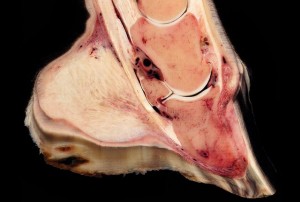Vaccination may exacerbate the signs in horses with chronic laminitis warn scientists in America. Dr David M Hood DVM PhD and his research team at the Texas A & M University have demonstrated an increased reactivity of the immune system in horses with chronic laminitis.
Intradermal (skin) testing (IDT) is a common procedure for investigating allergic disease. It is used to identify which substances, or allergens, produce an inflammatory reaction when a small amount is injected into the skin. A panel of allergens is used and those that produce a marked reaction are identified.
The researchers carried out intra-dermal skin tests on seven normal horses and on seven with chronic laminitis. All of the laminitic horses had rotation or sinking of the pedal bone and had been affected for at least a year or more. Only one laminitic mare had previously shown any signs of allergic skin disease. It had a bout of urticaria (hives) 6 months after contracting laminitis, but had shown no further signs for 7 months before the investigation began.
Each horse was sedated for the procedure. The allergens were injected at separate sites on the side of the neck. The panel of 70 antigens included moulds and dust, weeds, insects, grasses and trees. The response was assessed at 15 and 20 minutes, and 4 and 24 hours after injection.
The scientists noticed a significant difference in reactivity between the two groups. We found that horses with chronic laminitis have a significantly increased response to intradermal skin test when compared with normal horses reports Dr Hood. The difference was apparent at all time intervals tested except 24 hours, when only one of the chronic laminitic horses showed any reaction
As only one of the chronic laminitic horses had any history of previous allergic disease, the researchers suggest that it is more likely that the hyperreactivity develops as a result of the laminitis rather than being the original cause of the laminitis.
In the second part of the investigation, the researchers examined the cellular changes that occurred at the injection site. They injected three normal horses and three of the chronic laminitics with an antigen that had produced a maximal response in the first experiment. Then they took small samples of skin 30 minutes, 6, 24 and 48 hours afterwards. Horses with chronic laminitis had a more severe inflammatory response than the normal horses, and the response tended to last longer, although the differences were not statistically significant.
Our results show that, at some stage after developing laminitis, horses develop a hyperreactivity to certain antigenic stimuli. Dr Hood concludes. He points out that there is a small but ever present risk of horses with chronic laminitis suffering an exacerbation of signs following antigenic challenge. He advises that the risk should be discussed with owners before administering vaccines to chronic laminitic. He also suggests that the possibility of pre-existing laminitic changes should be considered when horses develop laminitis shortly after vaccination.
For more details see: Evaluation of systemic immunological hyperreactivity after intradermal testing in horses with chronic laminitis.
Ilka P Wagner, Christine A Rees, Robert W Dunstan, Kelly M Credile, David M Hood.
Am J Vet Res (2003) 64, 279 – 283











